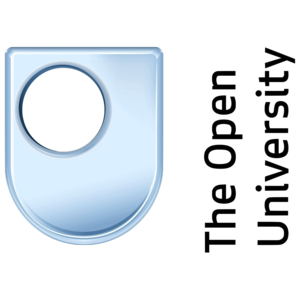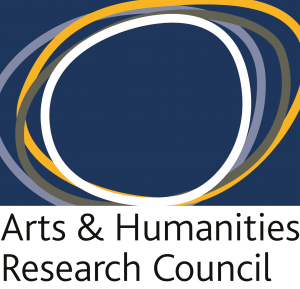Mapping Assets within the Media, Community and the Creative Citizen project
Conceptual and empirical frameworks
Asset based community development (ABCD) is an approach based on the premise that community groups will be better equipped to develop their projects if they can identify and mobilise assets they already have (which often are unrecognised) helping to bring people together, and build upon existing capabilities (Mathie and Cunningham 2002, McKnight and Kretzmann 1996). It has been deployed with a diverse set of projects across the Connected Communities programme to work with individuals and community groups articulate value about their localities, uncover hidden potential and visible resources, but also discover, often intangible qualities – such as talents, skills, knowledge, social relations – which they can mobilise to shape their visions and aspirations.
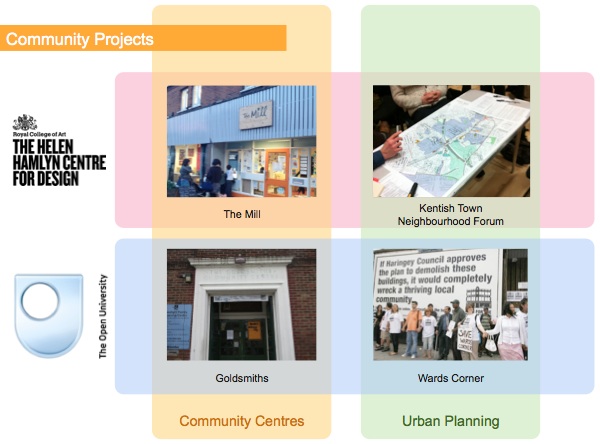
There are widespread assumptions that new media, such as social networking sites and web 2.0 platforms, can offer new forms of civic engagement, participation and expression. In working with 4 community-led projects we aimed at exploring what participants valued more about their localities and what they would like to change, what tools they used to communicate with other, exchange information and share stories, and how they would go about testing and creating digital media to help their projects grow and become stronger.
Researching within the community-led design strand of the Media, Community and the Creative Citizen project, Dr Giota Alevizou, Dr Katerina Alexiou, Dr Theo Zamenopolous (Open University), Ms Catherine Greene and Ms Gail Ramster (RCA), combined aspects stemming from the ABCD approach with dimensions stemming from theoretical approaches to social and cultural capital (e.g. Bourdieu, 1993; Halpern, 2005; Naughton, 2013), participatory planning/co-design as well as media and communications. The team aimed to develop an original approach asset mapping as a research, engagement method (through workshops and interviews) and a tool for co-designing emerging actions (with four groups in London). The aim has been to enable participants generate shared visions about their projects, discuss what they like and what they like to change in their localities, and exchange ideas about how to co-develop outputs and share their stories relating to their projects and aspirations using different technologies and media.
Four community groups were selected who had links with Community Partners – The Glass-House Community led Design and NESTA. Two groups already had already projects around redefining buildings as social, cultural, educational and entrepreneurial hubs (The Mill, a community centre in Walthamstow, and Goldsmiths Community Centre in Lewisham). Two are action groups around planning and regeneration: Kentish Town Neighbourhood Forum (KTNF) who have received funding to develop a neighbourhood plan, and Wards Corner Community Coalition (WCC) a grass-roots activist group campaigning to halt the demolition of a residential and business block and host of an indoor market in Tottenham.
Instruments
In developing the asset mapping methodology, the main focus was around each group’s projects and aspirations at the time. Sometimes a clear purpose was defined (e.g. how to engage others in developing a neighbourhood plan), in other cases the mapping workshop aimed at engaging participants to draw out aspects that would define collective projects for improving a space (and services). So participants took turns to discuss what they considered valuable or important in the locality and as group resources. By placing a sheet with three concentric circles, we asked individuals within the group to map what they consider as asset (current and potential), for both the campaign, and in relation to the wider area.
We used six categories of assets each represented by a different prop.
- Spaces (that a group may use including open spaces, social spaces, public space, built environment and physical spaces, e.g. parks) – prop: wooden blocks.
- Infrastructures (e.g. transport, wifi, social services, etc) – prop: puzzle pieces.
- Media (mainstream media, social media, information and communication technologies and tools) – prop: counters with printed labels for different types of media/communicative tool/practice.
- Groups, & associations, including organizations and businesses (that a group or individuals work with, are members of, or receive advice from) – prop: Place-holders [people could write on them].
- People (someone key to the project or someone with a particular skill) – prop: plastic people (pawns) with labels for writing.
- Other (incorporates anything that does not fit in the other categories e.g. festivals, stories, history, skills, emotions) – prop: Flags (people could write).
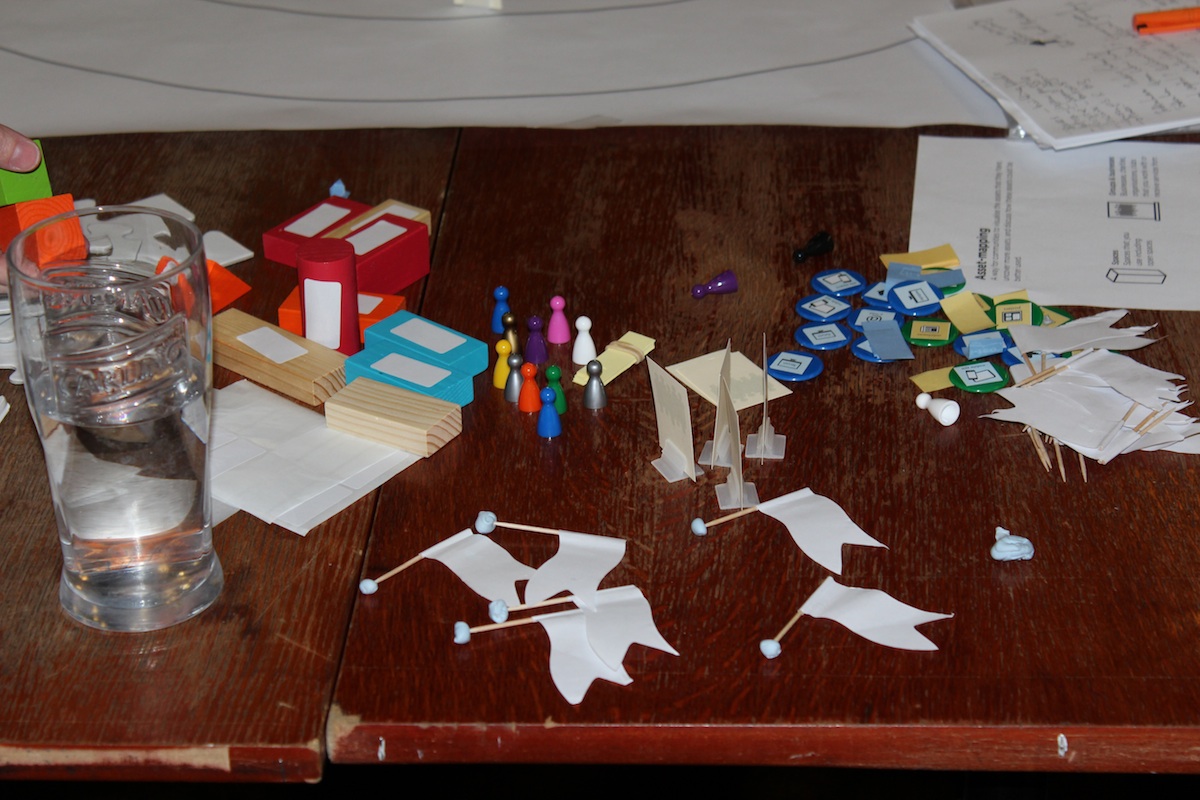
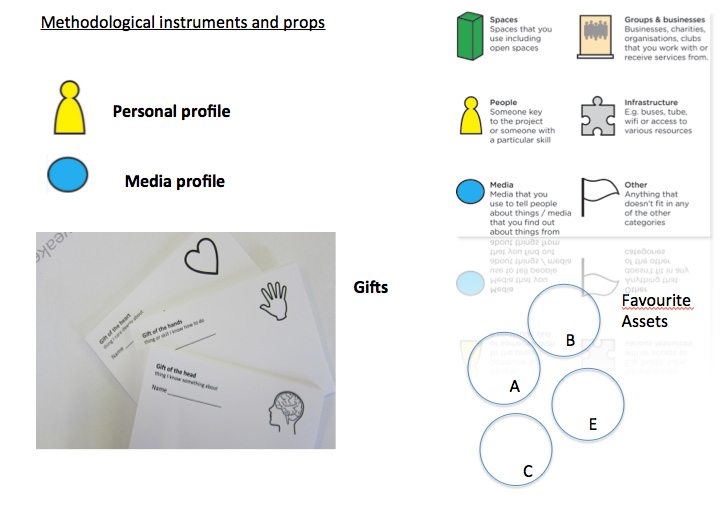
Processes & Outputs
The mapping process and the group discussion was useful for eliciting and recording values, cultural associations and perceptions of value; It provided a good way for unearthing social capital and the relationships of people with places, services, environments, through media networks and with each other.
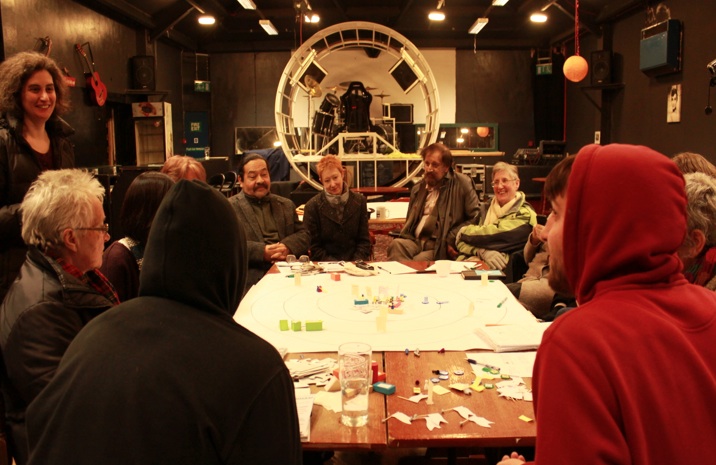
Asset Mapping workshops (picture: Wards Corner Community Coalition workshop). Turning from group discussions …
Insights from the group discussion and individual interviews: we asked each participant to reflect about the collective maps and develop their individual maps too. The processes produced rich visual materials and this participatory activity was reportedly satisfying for all, particularly in unleashing some confidence and creative thinking in talking about issues and things of value in groups and localities.
We produced static visualisations of the maps (using Adobe Illustrator) which we subsequently shared with the group in several meetings. These unearthed hotspots of cultural value offered insights and narratives about the localties, about aspects of ‘community economies’ (Gibson-Graham, 2003: 65) and dimensions of civic culture (Dalhgren, 2003; 2009) within the particular contexts.
By visualising the maps, we were able to gain an understanding and report back to groups (relatively quickly) about ideas, values and priorities participants they had expressed – in relation to current and potential areas for development.
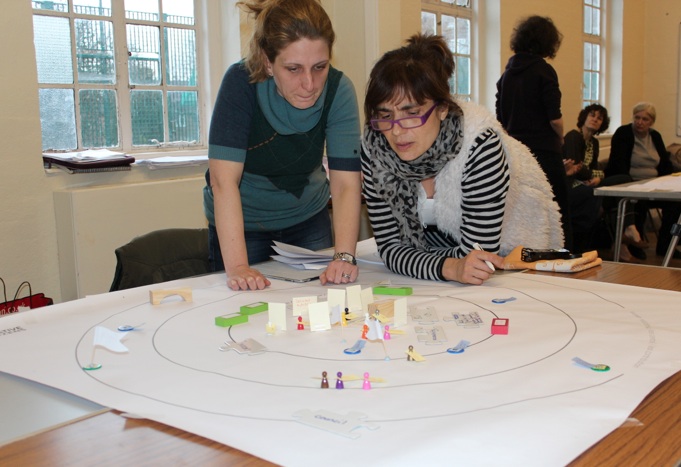
… to individual discussions, elicited insights about personal and collective values and actions (picture: Goldsmiths Community Centre workshop).
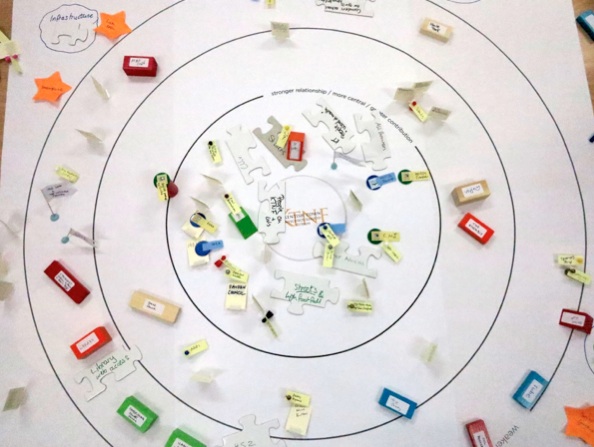
Asset Mapping with KTNF: We discussed current assets and would then move on to discuss the potential of these assets, such as whether assets that are currently of lower value could be harness and moved towards the centre. Discussing potential assets would inevitably generate ideas for how these assets could be used, beginning the creative process.
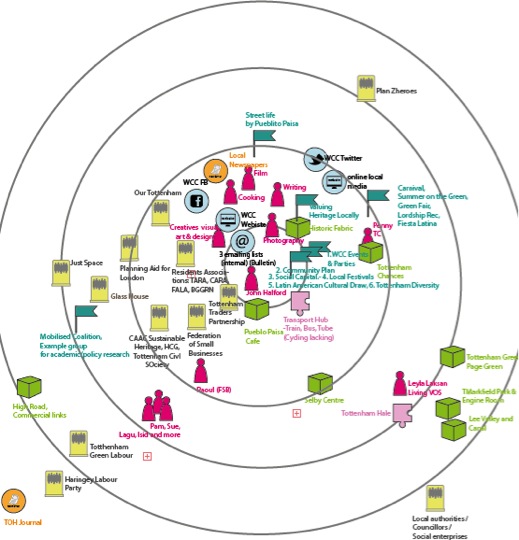

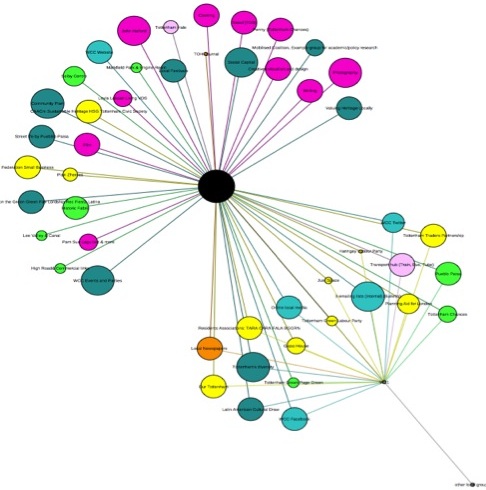
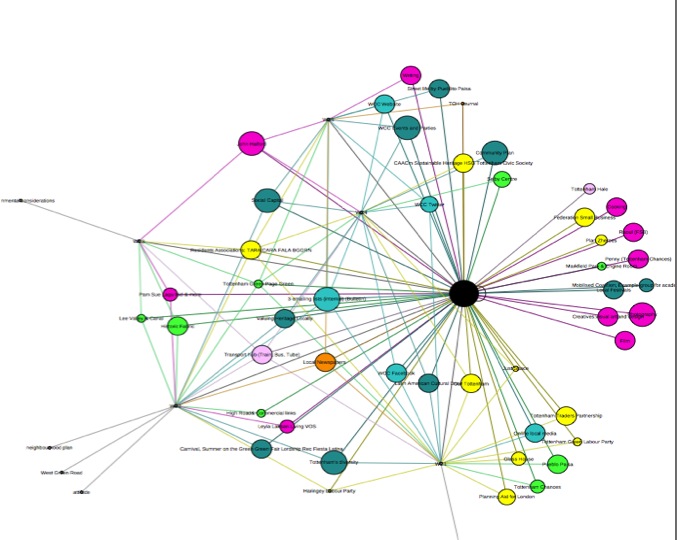
We also transcribed the maps and used some of the conversations and stories that the mapping exercises produced to discuss people’s thinking. In subsequent workshops and meetings, we were able to use the maps and brief insights from conversations in order to brainstorm further on ideas regarding the types of media and communicative practices that would best suit the emerging priorities of the groups, and discuss what steps to take towards co-creating media tools, towards telling stories and towards defining actions that would fit well with the priorities of each group. Facilitating the co-creation and co-design of media & digital interventions has been part of the Creative Citizen’s remit and separate funding and resources were allocated to support groups achieve their aims, as they emerged, and also they would fit with their creative and situated media practices. We aimed to explore ‘creative outputs’ and mediated practices within particular ‘symbolic domains’ (architecture, planning, local services) and engage with the community groups we supported through processes of co-design or co-production (Reich et al, 1996; Sanders and Stappers, 2008; Lee, 2008). These processes involved shaping ideas about the creation of communal, public spaces, community services, as well as digital or hybrid tools for civic participation.
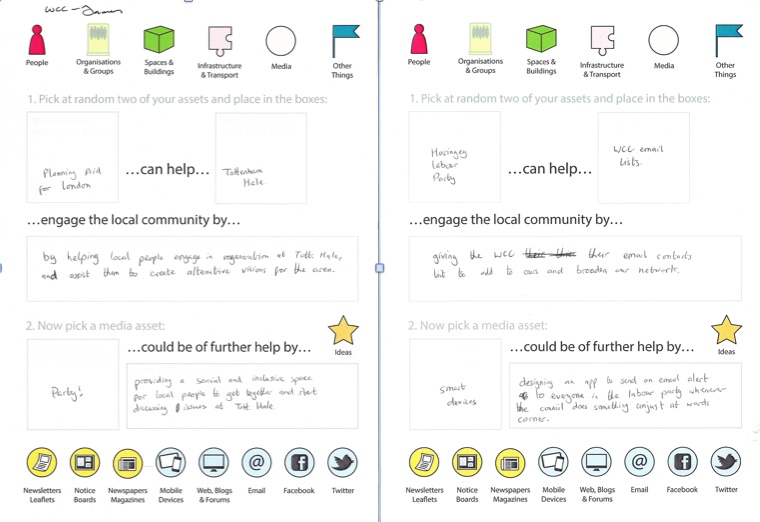
Creative, co-creation workshops: Example from utilising assets to generate ideas about: co-producing media outputs and engaging with relevant stakeholders.
Co-creating digital media for participatory planning: an example from Wards Corner Community Coalition
Wards Corner Community Coalition (WCC), one of the groups that was supported by the Open University team of researchers, identified the need for developing media platforms that would utilised existing material that would feature in an alternative community-led plan. The Community Plan – identified as central in the asset maps produced with the group – was at the time of the workshop under development. The group worked architectural designer Abigail, member of WCC, to put forward ideas, community feedback and designs in the planning application proposing the restoration of the Wards Corner building (LINKS URLs). This has been a contested site and host of a vibrant, indoor, Latin American Market above Seven Sister’s Tube in Tottenham, North London.
While visual content – in the form of three-dimensional computer generated sketches – existed alongside technical specifications and community input that would feature in the official planning application, the group had identified a key priority for co-designing any medium: the need to showcase the plan in an accessible way and engage further with those directly affected by any changes in the block. They strived to develop a platform for consultation or a platform that would give others the opportunity to express their voice and share ideas about the future.
Several ideas were floating around about different tools and media to help communicate the visual modalities of urban design (the projected image of the building) and the exchange others in a sensory experience of the plan in an interactive and immersive way. The question was also how to combine these visions for the future with content and community voices – which had already featured in the WCC website and beyond – and had been used to evoke the buildings’ (and the locality’s) social and cultural heritage. A workshop was facilitated by the group to elicit responses and brainstorm ideas further about the purpose, interface and technical interface of a media /technological platform that would serve these priorities. Asset mapping in this sense served as a tool for co-defining and, subsequently co-designing, such media tools.
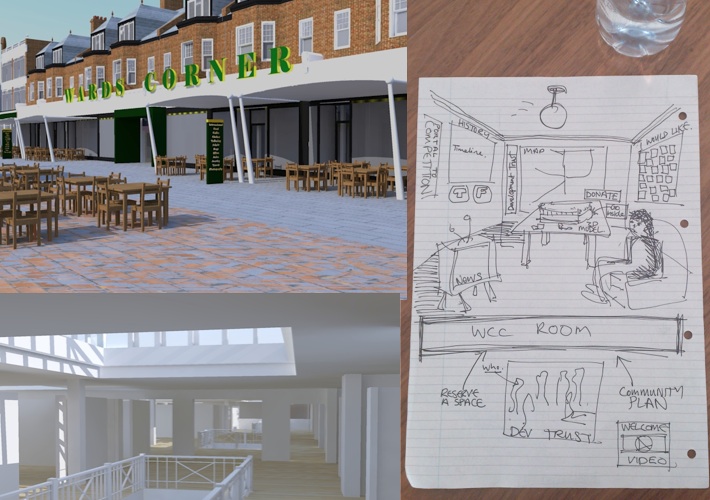
Sketching up ideas about the an ideal online platform to host a virtual tour community plan and to elicit feedback.
Sourcing on the creativity and commitment of several people within the WCC group – as it was unearthed in several workshops and meetings (including the asset mapping) – was paramount in ensuring the stages for the development of WCC Room within StickyWorld. StickyWorld was the main medium used to ‘translate’ the projected sensory & social experience of the building in proposed plan and to elicit feedback on the official application; it was also used to enhance the aura of alternative plan – the multicultural draw – an expressed asset about the area – and stimulate further engagement with the relevant stakeholders, who could perhaps have overlooked these aspects in the official document of the planning application.
This particular intervention has been situated with the group’s emerging creative media practices and was embedded in existing communicative practices. These include: using existing mailing lists and group websites and blogs to share documents, information and announcements. It also involved the co-production of a booklet to showcase the plan on StickyWorld, participating and hosting local events to showcase and engage others in the plan (virtually and physically) and identifying champions to showcase the plan and help recording voices and recommendations. By identifying these resources in asset mapping and subsequent meetings, discussions and workshops, we were able to co-define and inform stages of research and action and draw out aspects that would have not been necessarily apparent in initial stages.
Approaches to asset mapping methodologies are often used within urban and community informatics research to inform the design of technological platforms and locative media; these may offer opportunities to move beyond the conception of users as abstract / passive and into developing the conditions for the co-production of civic media with the view to creating contexts for more inclusive or representative communities (Foth and Adkins, 2006; Klaebe and Foth, 2007; Hearn, Roodhouse and Blakey, 2007).
Digital and networked media, but also creative arts practices (including participatory film-making and cultural animation, as several collaborators within this project have deployed in respective projects) can foster the activation and embeddedness of rich, multivalent conceptions of the situated experience of peoples’ environments and localities, of social connections and creative expressions. Creative expression in this respect, seeks to address both the process of the media-making (platforms, technologies, contents), but also use media practices and creative techniques to represent wider communities in a more inclusive manner.
Analysis, & reporting: opportunities & challenges for connecting rigorous insights with community priorities
Using mapping techniques allows to visually represent and also quantify the network of relationships between assets and participants perceptions of value. Using qualitative techniques such as thematic analysis and a combination of qualitative and quantitative social network analysis tools (e.g. Visone, Gephi) can also render important insights about the ways in which clusters of social /economic and cultural value are – and can be – developed, the relationships with groups, associations and the built or physical environment, and models of action are being negotiated.
What’s also important is that the stories exchanged in the asset mapping and related workshops raise several insights and contextual questions about the relationship of people and place focussing on:
- identity and belonging;
- connection and representation;
- perceptions and aspirations about the modes, modalities and models of participation;
- and ideas about the opportunities and challenges in engaging with policy and governance of localities and to exert influence in decision making.
In attempting to seal collaborations and develop a model for impact and knowledge transfer, asset mapping is conducted in the final stages of involvement with groups. An opportunity for reflection – based on maps and creative narratives from the previous year – a celebration of achievements and a guide for directing creative thinking to steps forward.

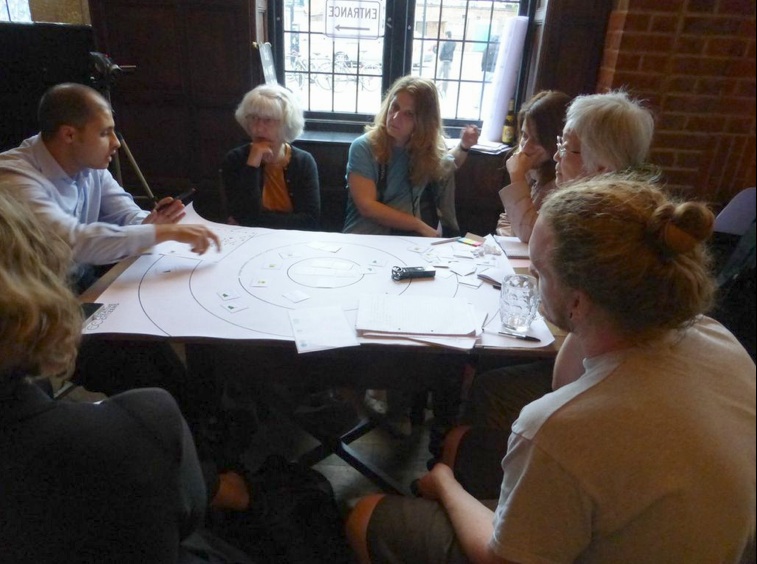
We are currently experimenting with digital tools within StickyWorld platform for showcase assetgrams and other visualisations, but also to enable the groups to perform asset mapping activities online.
How do communities groups feel about these approaches?
The feedback we have received tell us that participants value the approach to collective mapping as it enables them to see things differently, gain more confidence in articulating issues and priorities and think more creatively about future action. Some groups have appropriated some aspects to the approach for asset mapping presented and have performed their asset mapping to brainstorm ideas and engage others in their projects (See for example, how Goldsmiths Community Centre‘s community engagement facilitator reports about it). Other participants have reported that it is important for the researchers to become more embedded in the group’s priorities and meetings, gain a deep understanding of purposes and establish close connections and trust in order to ensure the feasibility and sustainability of projects.
Reflections
Asset mapping was one of the methodologies we deployed, and one we developed to immerse with action research for a 30 month-old project. We used this approach with the aim to provide some ideas which could potentially lead to actions and tangible outcomes for the community groups with worked with – whether through media outputs and via influencing communicative and civic practices in the field of placemaking and community led design.
Several tensions and ethical considerations exist revolving around this approach to asset mapping:
- lifespan of activities and the tension between community priorities and researchers’ schedules and other priorities
- getting adequate representation for all stakeholders engaged
- recording, representing and analysing all data is exceptionally complex and time-consuming and is difficult to be adjusted to specific groups’ priorities
- ethical considerations regarding community anonymity and the need for visibility to fuel action
- gaining trust of community groups and engage individuals as peer collaborators’ involves developing reporting guidelines and negotiating division of labour regularly
- enough contextual information (about group’s history, relationships and civic practices, issues around areas/localities, etc) may be recorded (using interviews and participatory ethnography approaches) and analysed to identify ways to build capacity and influence, but also to fuel rigorous and theoretically informed analytical insights
The project runs until November 2014.
Related projects:
Media, Community and the Creative Citizen, Scaling Up Co-Design, Valuing Community Led Design, Unearthing Hidden Assets.
Related Posts:
Creative Placemaking: Communicative Ecologies and Asset Mapping with Wards Corner.
Creative Modalities of Planning.
An appropropriation of asset mapping with Hyperlocal Reporters.









